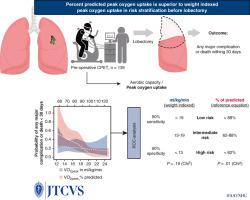当前位置:
X-MOL 学术
›
J. Thorac. Cardiovasc. Surg.
›
论文详情
Our official English website, www.x-mol.net, welcomes your feedback! (Note: you will need to create a separate account there.)
Percent predicted peak oxygen uptake is superior to weight-indexed peak oxygen uptake in risk stratification before lung cancer lobectomy
The Journal of Thoracic and Cardiovascular Surgery ( IF 6 ) Pub Date : 2024-03-05 , DOI: 10.1016/j.jtcvs.2024.02.021 Karolina Kristenson , Kristofer Hedman
The Journal of Thoracic and Cardiovascular Surgery ( IF 6 ) Pub Date : 2024-03-05 , DOI: 10.1016/j.jtcvs.2024.02.021 Karolina Kristenson , Kristofer Hedman

|
To improve preoperative risk stratification in lung cancer lobectomy by identifying and comparing optimal thresholds for peak oxygen uptake (VO) presented as weight-indexed and percent of predicted values, respectively. This was a longitudinal cohort study including national registry data on patients scheduled for cancer lobectomy that used available data from preoperative cardiopulmonary exercise testing. The measured VO was indexed by body mass (mL/kg/min) and also compared with 2 established reference equations (Wasserman-Hansen and Study of Health in Pomerania, respectively). By receiver operating characteristic analysis, a lower 90% specificity and an upper 90% sensitivity threshold were determined for each measure, in relation to the outcome of any major complication or death. For each measure and based on these thresholds, patients were categorized as low risk, intermediate risk, or high risk. The frequency of complications was compared between groups using χ. The frequency of complications differed significantly between the proposed low-, intermediate-, and high-risk groups when using % predicted Study of Health in Pomerania (5%, 21%, 35%, = .007) or % predicted Wasserman-Hansen (5%, 25%, 35%, = .002) but not when using the weight-indexed VO groups (7%, 23%, 15%, = .08). Nonsignificant differences were found using the threshold <15 mL/kg/min ( = .34). This study showed that weight-indexed VO was of less use as a marker of risk at the lower range of exercise capacity, whereas % predicted VO was associated with a continuously increasing risk of major complications, also at the lower end of exercise capacity. As identifying subjects at high risk of complications is important, % predicted VO is therefore preferable.
中文翻译:

肺癌肺叶切除术前风险分层中预测峰值摄氧量百分比优于体重指数峰值摄氧量
通过识别和比较分别以体重指数和预测值百分比表示的峰值摄氧量 (VO) 的最佳阈值,改善肺癌肺叶切除术的术前风险分层。这是一项纵向队列研究,包括计划进行癌症肺叶切除术的患者的国家登记数据,该研究使用了术前心肺运动测试的可用数据。测量的摄氧量以体重 (mL/kg/min) 为索引,并与 2 个已建立的参考方程(分别为 Wasserman-Hansen 和 Study of Health in Pomerania)进行比较。通过接受者操作特征分析,确定了与任何主要并发症或死亡结果相关的每项测量的较低 90% 特异性和较高 90% 敏感性阈值。对于每项测量,并根据这些阈值,将患者分为低风险、中风险或高风险。使用 χ2 比较组间并发症的发生率。当使用波美拉尼亚健康研究预测百分比 (5%, 21%, 35%, = .007) 或 Wasserman-Hansen 预测百分比 ( 5%, 25%, 35%, = .002),但使用体重指数 VO 组时则不然 (7%, 23%, 15%, = .08)。使用阈值 <15 mL/kg/min (= .34) 发现不显着差异。这项研究表明,在运动能力较低范围内,体重指数摄氧量较少用作风险标记,而预测摄氧量百分比与持续增加的主要并发症风险相关,在运动能力较低范围内也是如此。由于识别并发症高风险的受试者很重要,因此预测 VO 百分比更可取。
更新日期:2024-03-05
中文翻译:

肺癌肺叶切除术前风险分层中预测峰值摄氧量百分比优于体重指数峰值摄氧量
通过识别和比较分别以体重指数和预测值百分比表示的峰值摄氧量 (VO) 的最佳阈值,改善肺癌肺叶切除术的术前风险分层。这是一项纵向队列研究,包括计划进行癌症肺叶切除术的患者的国家登记数据,该研究使用了术前心肺运动测试的可用数据。测量的摄氧量以体重 (mL/kg/min) 为索引,并与 2 个已建立的参考方程(分别为 Wasserman-Hansen 和 Study of Health in Pomerania)进行比较。通过接受者操作特征分析,确定了与任何主要并发症或死亡结果相关的每项测量的较低 90% 特异性和较高 90% 敏感性阈值。对于每项测量,并根据这些阈值,将患者分为低风险、中风险或高风险。使用 χ2 比较组间并发症的发生率。当使用波美拉尼亚健康研究预测百分比 (5%, 21%, 35%, = .007) 或 Wasserman-Hansen 预测百分比 ( 5%, 25%, 35%, = .002),但使用体重指数 VO 组时则不然 (7%, 23%, 15%, = .08)。使用阈值 <15 mL/kg/min (= .34) 发现不显着差异。这项研究表明,在运动能力较低范围内,体重指数摄氧量较少用作风险标记,而预测摄氧量百分比与持续增加的主要并发症风险相关,在运动能力较低范围内也是如此。由于识别并发症高风险的受试者很重要,因此预测 VO 百分比更可取。



























 京公网安备 11010802027423号
京公网安备 11010802027423号